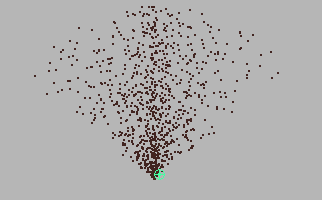A particle object is
a collection of particles that share the same attributes. You can
create particle objects containing a single particle or millions
of particles. Each particle in a scene belongs to some particle
object. An overview of how you create particle effects follows:
Creating particles
You can create particles
several ways:
- Place particles in the workspace with
the Particle Tool (see
Create particles).
- Create a particle emitter, which generates
and animates the motion of particles automatically (see
Emitters).
- Cause particles that collide with geometry
to create new particles upon contact (see
Particle collisions).
Set display attributes
You change the way particles
look with several techniques:
Animate the particles
You can animate particle
motion several ways:
- Set the position, velocity, or acceleration
attributes of particles. You can also set keys to animate an entire
particle object’s translate, scale, and rotate attributes. See
Animate particles
- Apply fields, such as gravity, to particles
(see
Overview of fields).
- Turn geometry into a collision object
and bounce particles off it (see
Particle collisions).
- Make the particles follow a moving goal
object (see
Goals).
Render the particles
Rendering is the final
step to creating particle effects. Depending on the render type
you select, you render the particles with hardware rendering or
software rendering. See
Choose how particles render.



